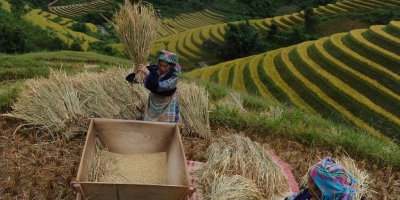
Big data can help forecast flooding and drought seasons. Source: AFP
Cambodia is optimizing farming yields with big data insights
- Big data might hold the key to unlocking the sustainable potential of the battered Cambodian agriculture sector
Cambodia’s agricultural economy has been taking some major hits over the last two decades, but can an analysis-driven combination of big data and the internet of things (IoT) help make a difference in the sector like they have done elsewhere in Southeast Asia?
The corrosive effects of ongoing climate changes and a significant dropoff in production output have been hailed by industry watchers as the main reasons why Cambodia’s agriculture sector has seen growth decline from 7.2% in 2003-2007, to 4.5% between 2008-2012, and is now just around 1% in recent years.
The agriculture, forestry, and fishing sectors combined are contributing nearly 9% less to the country’s GDP than they were just six years ago, as the two contrary effects of prolonged droughts and floods have decimated harvests, destroyed maize-planted land, and limited access to water needed for replanting.
These challenges are only expected to get worse as climate change intensifies, not to mention the added pressures of limited access to credit facilities and border closures as a knock-on effect of the pandemic. Fortunately for smallholder farmers throughout the kingdom, the government had set its sights on upgrading the local agrarian sector to create a more competitive and sustainable model over the next ten years, in a plan called the Agricultural Sector Master Plan 2030 (ASMP 2030).
Under the ASMP 2030, obsolete agricultural machinery will be phased out in favor of modern techniques that can increase yields and productivity cost-effectively, and these could encompass a wide array of solutions. Local farmers are already looking at innovations like using drone technology to spray crops and reduce exposure to harmful pesticides, or automating irrigation systems to remotely manage the dispersal of valuable water resources.
Sowing big data to reap value
But it is the alluring potential of big data, IoT devices, and AI to more effectively manage a wide array of farming applications that has invested parties especially excited. Researchers at the IIC University of Technology in Phnom Penh, for instance, are studying the convergence of IoT and data-driven farm management techniques to help increase agricultural yields by “planning input costs, reducing losses, and by harnessing resources more effectively.”
The research indicates that analyzing farm data alongside historical environmental data, creates the most ideal set of circumstances in which to optimize crop growth and increase agricultural yield. For example, advanced data of upcoming heavy rainfall could give farmers sufficient lead time to mobilize resources to protect the crops or even to harvest them early instead of having them all destroyed.
Cambodia’s classical agriculture scene is ripe to leverage big data to modernize the sector, as this would be a perfect opportunity to collect and analyze a vast quantity of data. This would be a critical hurdle to overcome, but machine learning could be applied to make sense of the information, and the compiled data would be a foundational building block to digitizing the agriculture value chain.
Cambodia’s Ministry of Agriculture, Forestry and Fisheries (MAFF) is also in the process of establishing the country’s Agricultural Big Data Platform (ABDP), which will be a holistic database of verified information on the local industry. Having such a data resource opens up the possibility of an agricultural product monitoring and traceability system, which is interestingly already being implemented in the private sector in the form of a blockchain-based platform called BlocRice.
BlocRice digitally tracks orders and contracts between farmers, exporters, and buyers, increasing the transparency in market prices and contractual terms, empowering smallholder farmers, and helping ensure they receive fairer payments.
The influx of buyers and sellers on the same platform will allow data to be gathered on yields, best practices, and practical challenges facing the community. The collected data could be tapped to build predictive models that can eventually forecast price fluctuations, weather conditions, and future yields. From crop recommendations to consumer buying habits, big data can take the guesswork out of farming and better the livelihoods of farmers using provable, practical insights in the long run.
READ MORE
- Strategies for Democratizing GenAI
- The criticality of endpoint management in cybersecurity and operations
- Ethical AI: The renewed importance of safeguarding data and customer privacy in Generative AI applications
- How Japan balances AI-driven opportunities with cybersecurity needs
- Deploying SASE: Benchmarking your approach


